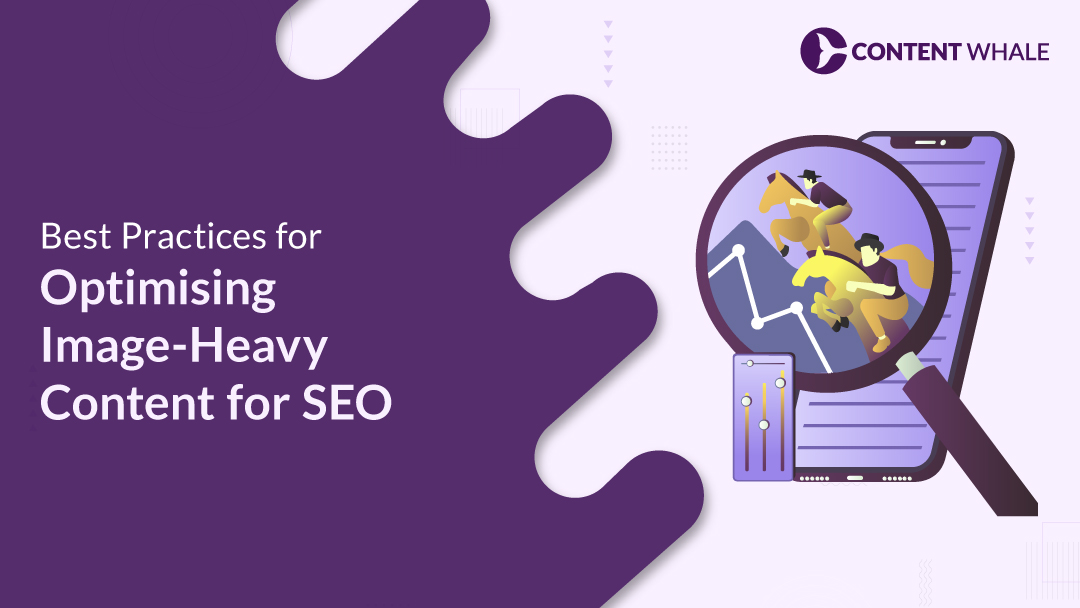In today’s visually-driven world, image-heavy content plays a significant role in enhancing the user experience and driving engagement. However, when images are not properly optimized, they can slow down your website, impacting both search engine rankings and user satisfaction. This makes image optimization SEO an essential aspect of digital marketing.
Images can enhance your website’s visual appeal, but they also require careful handling to ensure they contribute positively to your SEO efforts. From alt text optimization to image compression, adopting best practices for seo for visuals is essential to improve search rankings and user experience.
In this guide, we will explore the key strategies for optimizing images, covering everything from file size reduction to image sitemaps. By following these steps, you can ensure your image-heavy content is both beautiful and search-engine friendly.
Why Does Image Optimisation Matter for SEO?
Images significantly improve the visual appeal of your content, increasing engagement and reducing bounce rates.
Studies show that users are more likely to stay on websites that feature rich media, including images, videos, and infographics.
A well-optimized image, when paired with engaging text, can improve both time on site and conversion rates.
Improving Site Speed and SEO Rankings
One of the primary reasons why image optimisation matters is its direct impact on site speed. Large, unoptimised images can cause slow loading times, which frustrates users and negatively impacts search engine rankings.
According to Google, page speed is a critical ranking factor. Optimizing image sizes and compressing them without sacrificing quality can result in faster loading times, leading to better SEO performance.
Impact of Image SEO on Mobile and Visual Search
As mobile usage continues to rise, so does the importance of optimizing images for mobile-first indexing. Mobile-friendly, fast-loading images are essential for retaining users and improving SEO rankings on mobile search.
Additionally, with the rise of visual search tools like Google Lens and Pinterest, image optimization SEO are becoming more discoverable, opening new avenues for traffic generation.
Best Practices for Image File Size and Compression
Why File Size Matters
The size of your images plays a critical role in how quickly your website loads. Large, high-resolution images may look stunning but can slow down your website, leading to a poor user experience and higher bounce rates.
image optimization SEO Reduce image file sizes is essential to ensure quick page load times and a smoother browsing experience. This, in turn, improves SEO rankings as Google rewards fast-loading sites.
Image Compression Techniques
There are several tools available to compress images without compromising their quality.
Tools like TinyPNG and PEGmini are popular choices that can drastically reduce file sizes while maintaining a high visual standard.
For WordPress users, plugins like Smush automatically compress images as you upload them, streamlining the optimisation process.
Choosing the Right Image Formats
The file format you choose also affects both the quality and size of your images.
Typically, JPEG is preferred for photographs and rich images due to its balance of quality and file size.
PNG is ideal for images with transparent backgrounds or logos, but it tends to have larger file sizes.
WebP images are increasingly popular, offering superior compression and quality compared to older formats, making them a great option for speeding up page load times.
Responsive Images for Optimal Performance
Responsive images are essential for ensuring that your content performs well on all devices.
Using the <code><img srcset></code> attribute, you can serve different image resolutions to different devices, such as mobile phones, tablets, and desktops.
This approach improves page speed by delivering the right image size based on the user’s device, enhancing both user experience and image optimization SEO.
How to Optimize Image Alt Text for SEO
Alt text serves two key purposes: making images accessible to visually impaired users and helping search engines understand the content of the image.
Search engines like Google cannot “see” images the way humans do, so they rely on alt text to comprehend the image’s context.
Alt text also plays a significant role in helping images rank in Google Image Search, making your content more discoverable.
Writing Descriptive, Keyword-Rich Alt Text
When writing alt text, it’s important to be both descriptive and concise. Your alt text should accurately describe the image while incorporating relevant keywords in a natural way.
However, avoid keyword stuffing, as Google’s algorithms can penalize this practice. Instead, focus on creating alt text that serves both SEO and user accessibility needs.
For example, instead of “image of a laptop,” use something more specific like “sleek silver laptop with Retina display on a wooden desk.”
Best Practices for Different Image Types
Different image types require different alt text strategies. For product images, include the product name and key features. For infographics, summarize the content and key insights of the infographic.
Decorative images, which do not add substantial value to the content, can be tagged with empty alt attributes (alt=””) to ensure that they do not negatively affect SEO or accessibility.
How Alt Text Impacts Google Image Search Ranking
Properly optimized alt text can significantly improve your chances of ranking higher in Google Image Search.
This is especially important for eCommerce websites and image-heavy content, where visuals are a critical aspect of user engagement.
By writing thoughtful and accurate alt text, you enhance both SEO and the accessibility of your site.
Optimizing Image Titles, Captions, and Metadata
Adding Context with Image Titles and Captions
While alt text is primarily used for accessibility and SEO purposes, image titles and captions provide context directly to users.
Titles are displayed when a user hovers over an image, offering a brief description or additional information.
Captions, on the other hand, appear directly beneath the image and are especially useful for clarifying or expanding on the image’s relevance within the content.
Using descriptive titles and captions can enhance user engagement, as readers often scan captions to gain quick insight into an image.
Although captions do not have a direct impact on image SEO, they improve user experience, which indirectly benefits your SEO by lowering bounce rates and increasing time on page.
Using Metadata (EXIF Data) to Optimize Images
Image metadata, often referred to as EXIF (Exchangeable Image File Format) data, contains information such as the camera settings, date, time, and location of the photo.
While some metadata can be stripped away to reduce file sizes, relevant metadata can enhance image searchability. Google uses this data to better understand images, so it’s a good idea to include important keywords in your metadata while keeping it concise.
Best Practices for Keeping Metadata Relevant
When optimizing images for SEO, it’s essential to balance the inclusion of metadata with the need to reduce file sizes.
Keep your metadata relevant and concise. Avoid including unnecessary details that could bloat the image file without contributing to search engine ranking.
Regularly audit your images to ensure that your metadata is up-to-date and accurately reflects the content of the image.
Implementing Lazy Loading for Image-Heavy Pages
What is Lazy Loading?
Lazy loading is a technique that delays the loading of images until they are needed. Instead of loading all images on a page as soon as the user arrives, lazy loading only loads images when they are about to enter the user’s viewport.
This can drastically reduce initial page load times, especially on pages with a large number of images.
How Lazy Loading Benefits SEO
Lazy loading improves SEO for image-heavy pages by reducing the amount of data that needs to be loaded upfront. By enhancing page speed and performance, lazy loading directly contributes to better search engine rankings.
Additionally, lazy loading helps conserve bandwidth for users on mobile devices, offering a smoother browsing experience and potentially improving mobile SEO performance.
Tools and Plugins for Lazy Loading
For website owners and developers, implementing lazy loading is easier than ever. Many content management systems (CMS) and website builders offer plugins and tools that automate the process.
For example, WP Rocket and LazyLoad are popular WordPress plugins that allow you to enable lazy loading with minimal effort.
These tools ensure that your images are only loaded when necessary, improving both user experience and SEO performance.
Using Image Sitemaps for Better Indexing
The Importance of Including Images in Sitemaps
Search engines like Google rely on sitemaps to discover and index content on your website. Including image optimization SEO in your sitemap ensures that search engines can find and index your visuals more easily.
By adding images to your sitemap, you enhance their visibility in both regular and Google Image Search results, increasing the chances of driving organic traffic.
How to Create and Submit an Image Sitemap
Creating an image sitemap is similar to creating a standard sitemap, but it specifically focuses on your image content.
Many SEO tools and plugins, such as Yoast SEO for WordPress, automatically generate sitemaps that include images. If you prefer manual control, you can create an image sitemap by adding image URLs within your regular sitemap or generating a separate sitemap exclusively for images.
Once your image sitemap is created, submit it via Google Search Console to ensure that your images are indexed correctly.
Best Practices for Maintaining Your Image Sitemap
Keeping your sitemap up-to-date is crucial for effective image optimisation.
Whenever you add new images or remove old ones, ensure that your sitemap reflects these changes.
Regularly auditing and updating your sitemap can help search engines crawl your site more efficiently, improving your overall SEO performance.
Additionally, avoid including low-quality or unnecessary images that may hinder your search engine rankings.
Image Optimisation for Visual Search
With the rise of tools like Google Lens, Pinterest Lens, and even Amazon’s product image search, visual search is becoming a key player in SEO strategies.
Visual search allows users to search by uploading or scanning images instead of typing keywords, creating a new opportunity for businesses to reach users who prefer this search method.
As visual search technology continues to improve, optimizing your images for this type of search can give you a competitive edge.
While traditional SEO focuses on text-based searches, visual search optimization ensures that your images are discoverable by search algorithms that interpret visuals, making it crucial for image-heavy content.
Best Practices for Visual Search Optimisation
To make your images more discoverable in visual search results, you need to optimise them beyond just alt text and file size. Here are some best practices:
- High-Quality, Relevant Images: Ensure that all images are high-resolution and relevant to the content they represent.
- Descriptive Filenames: Use filenames that describe the image’s content clearly, such as “red-sneakers-nike.jpg” instead of “image123.jpg”.
- Schema Markup: Implement schema markup to help search engines understand the context of your images, improving their visibility in search results.
- Mobile-Friendly: Given the rise of mobile visual search, ensure that your images are mobile-optimized and load quickly on mobile devices.
Optimizing Images for Both Text-Based and Visual Search
Optimizing for both text-based and visual search requires a holistic approach.
While keywords and metadata are important for traditional search, ensuring that images are clear, detailed, and contextually relevant is key for visual search success.
Focus on providing images that not only complement your written content but also stand out as independent resources capable of attracting traffic from visual search engines.
Seems like a hassle? Let us help you!
Conclusion
Image optimisation plays a pivotal role in improving your website’s SEO performance.
From reducing file sizes to writing compelling alt text, the steps you take to optimise your images will not only enhance user experience but also boost your visibility in both traditional and visual search engines.
By implementing strategies like lazy loading, using the right image formats, and creating image sitemaps, you can ensure that your image-heavy content is both fast-loading and discoverable.
Remember, ongoing optimisation is key to long-term success in image SEO. As search algorithms evolve and user expectations shift, staying on top of the latest image optimisation techniques will help keep your site competitive and engaging for your audience.
Seems hassle! Don’t worry; we are here for you. Reach out to us today!
FAQs
1. How does image optimization affect SEO rankings?
Optimizing images improves site speed, enhances user experience, and ensures that images are discoverable by search engines. Faster-loading pages and well-optimised visuals contribute to better image optimization SEO rankings by reducing bounce rates and increasing user engagement.
2. What is the best file format for optimizing images for the web?
The ideal file format depends on the type of image. JPEG is commonly used for photographs due to its balance of quality and file size, while PNG is ideal for images requiring transparency. WebP is increasingly popular for its superior compression and quality, making it a great option for web use.
3. How often should I update image alt text and metadata?
Regularly auditing and updating your alt text and metadata is essential to ensure accuracy and relevance. It’s a good practice to review your image optimisations every few months or whenever you update your website content.
4. Does lazy loading improve SEO for image-heavy pages?
Yes, lazy loading improves SEO by reducing initial page load times, which enhances user experience and site performance. It ensures that images are only loaded when needed, thus saving bandwidth and improving site speed, especially on image-heavy pages.
5. What tools can I use to compress and optimise images for SEO?
Several tools can help with image compression, including TinyPNG, JPEGmini, and Kraken.io. For WordPress users, plugins like Smush and WP Rocket make it easy to automate image compression and optimisation processes.





